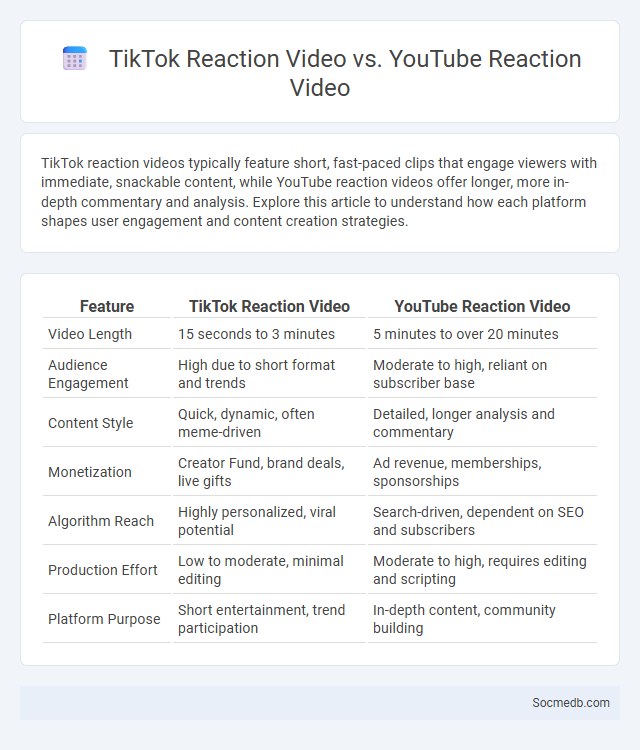
Photo illustration: TikTok Reaction Video vs YouTube Reaction Video
TikTok reaction videos typically feature short, fast-paced clips that engage viewers with immediate, snackable content, while YouTube reaction videos offer longer, more in-depth commentary and analysis. Explore this article to understand how each platform shapes user engagement and content creation strategies.
Table of Comparison
| Feature | TikTok Reaction Video | YouTube Reaction Video |
|---|---|---|
| Video Length | 15 seconds to 3 minutes | 5 minutes to over 20 minutes |
| Audience Engagement | High due to short format and trends | Moderate to high, reliant on subscriber base |
| Content Style | Quick, dynamic, often meme-driven | Detailed, longer analysis and commentary |
| Monetization | Creator Fund, brand deals, live gifts | Ad revenue, memberships, sponsorships |
| Algorithm Reach | Highly personalized, viral potential | Search-driven, dependent on SEO and subscribers |
| Production Effort | Low to moderate, minimal editing | Moderate to high, requires editing and scripting |
| Platform Purpose | Short entertainment, trend participation | In-depth content, community building |
Introduction to Reaction Videos
Reaction videos capture authentic emotional responses to various content types, making them highly engaging for viewers seeking genuine connections. These videos leverage real-time commentary to drive user interaction and foster online communities around shared interests. Your participation in creating or watching reaction videos can enhance social media engagement and content relatability.
What Are TikTok Reaction Videos?
TikTok reaction videos showcase your genuine response to trending content, allowing you to engage with popular clips in a personalized way. These videos feature your facial expressions and commentary as you watch original TikTok posts, enhancing viewer connection and interaction. By creating reaction videos, you tap into viral trends, boosting your visibility and fostering community engagement on the platform.
What Are YouTube Reaction Videos?
YouTube reaction videos are content where creators film their responses to various media, such as music videos, trailers, or viral clips, capturing authentic emotions and commentary. These videos engage viewers by providing relatable perspectives and often spark community discussions through shared experiences. Popular among diverse audiences, reaction videos leverage YouTube's algorithm to boost visibility and subscriber growth.
Key Differences Between TikTok and YouTube Reaction Videos
TikTok reaction videos typically feature short, spontaneous clips with quick edits and vertical formats, maximizing viewer engagement through brevity and directness. YouTube reaction videos tend to be longer, more detailed, and often include in-depth commentary with horizontal video formats, catering to audiences seeking comprehensive analysis. The algorithm-driven discoverability on TikTok favors viral, fast-paced content, whereas YouTube rewards sustained viewer retention and subscriber interaction.
Audience Engagement: TikTok vs YouTube
TikTok's algorithm excels at boosting audience engagement through short, compelling videos that encourage immediate interaction like comments, likes, and shares. YouTube offers deeper engagement with longer content, fostering community through detailed comments, subscriptions, and live streams. Understanding your target audience's preferences on these platforms can maximize your content's reach and interaction rates.
Content Creation Strategies for Reaction Videos
Effective content creation strategies for reaction videos include selecting trending topics or viral content that resonate with your target audience to maximize engagement. Your video should capture authentic and relatable reactions, enhancing viewer connection and encouraging sharing. Incorporate clear, high-quality visuals and concise editing to maintain pacing and viewer interest throughout the reaction process.
Virality and Reach: Platform Comparisons
Instagram's visual-centric algorithm promotes rapid content sharing, enhancing virality through Stories and Reels, while TikTok's For You Page uniquely boosts reach by tailoring videos to user interests with powerful AI-driven recommendations. Facebook offers extensive reach due to its vast user base and diverse content formats, but organic virality is often limited by algorithmic prioritization of personal connections. Twitter emphasizes real-time conversations, enabling swift viral spread of news and hashtags, though its character limit influences content depth and engagement patterns.
Monetization Opportunities: TikTok vs YouTube
TikTok and YouTube offer distinct monetization opportunities tailored to different content creators. TikTok's Creator Fund and brand partnerships provide fast revenue streams through short-form viral videos, while YouTube's Partner Program offers ad revenue, channel memberships, and Super Chats for comprehensive long-form content monetization. YouTube generally yields higher earnings per view due to its established ad ecosystem, whereas TikTok excels in audience engagement and rapid follower growth.
Trends and Popularity in Reaction Video Formats
Reaction video formats dominate social media trends by offering authentic and engaging content that resonates with diverse audiences globally. Platforms like TikTok, YouTube, and Instagram drive the popularity of these videos, as users seek real-time emotional responses to viral events, music releases, and pop culture moments. Your engagement with reaction videos amplifies their reach, making them a powerful tool for creators to connect and grow their online communities.
Future of Reaction Videos Across Platforms
Reaction videos will continue evolving as AI-powered tools enable creators to produce more immersive and personalized content, increasing audience engagement across platforms like YouTube, TikTok, and Instagram. Enhanced algorithmic recommendations and real-time feedback integration will drive higher viewer interaction and retention rates. Emerging technologies such as VR and AR will further transform reaction video experiences, making them more interactive and immersive for users worldwide.
 socmedb.com
socmedb.com